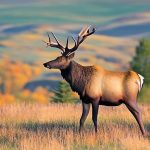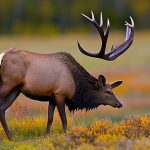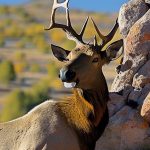Your cart is currently empty!
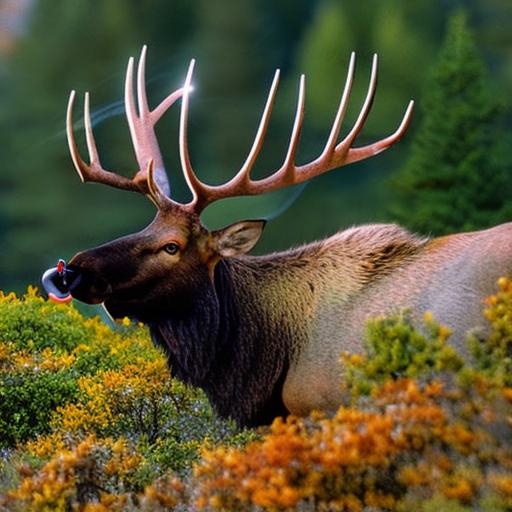
Muzzleloader Magic: Conquering the Wild with Elk Hunting

Muzzleloader hunting for elk is an exhilarating and challenging experience that many hunters seek out. The use of a muzzleloader adds an extra level of difficulty to the hunt, as it requires a different set of skills and techniques compared to modern firearms. The thrill of getting up close and personal with these majestic animals, combined with the challenge of using a muzzleloader, makes for an unforgettable hunting experience.
Key Takeaways
- Understanding the equipment and techniques of muzzleloader hunting is crucial for success.
- Essential tips for elk hunting with a muzzleloader include proper preparation and scouting.
- Finding the best elk hunting spots with a muzzleloader requires knowledge of the wilderness and elk behavior.
- Following elk trails and signs in the wild is an art that can be learned with practice.
- Effective strategies for muzzleloader elk hunting include stalking and ambushing while maintaining stealth.
The Basics of Muzzleloader Hunting: Understanding the Equipment and Techniques
A muzzleloader is a type of firearm that is loaded from the muzzle, or the open end of the barrel. It uses black powder or a black powder substitute as propellant, and a projectile such as a bullet or a round ball. Muzzleloaders come in various types, including flintlock, percussion cap, and inline. Each type has its own advantages and disadvantages.
Flintlock muzzleloaders are the oldest type and use a flint to create sparks that ignite the powder in the barrel. They are known for their historical charm but can be more challenging to use in wet weather conditions. Percussion cap muzzleloaders use a small explosive cap to ignite the powder, making them more reliable in damp conditions. Inline muzzleloaders are the most modern type and have a breech plug that allows for easier loading and cleaning.
Basic techniques for muzzleloader hunting include loading and firing the weapon. Loading involves measuring out the correct amount of powder, placing it in the barrel, followed by seating the projectile on top. Firing requires carefully aiming at the target and pulling the trigger. It is important to note that muzzleloaders have a slower rate of fire compared to modern firearms, so accuracy and patience are key.
Preparing for the Hunt: Essential Tips for Elk Hunting with a Muzzleloader
Physical fitness and endurance are crucial when hunting elk with a muzzleloader. Elk hunting often involves long hikes and traversing rugged terrain, so being in good shape will greatly enhance your chances of success. It is recommended to engage in regular exercise and cardio workouts leading up to the hunt to build stamina and endurance.
In terms of gear and equipment, there are a few essentials that every muzzleloader elk hunter should have. These include a quality muzzleloader, ammunition, a cleaning kit, binoculars, a range finder, a backpack, appropriate clothing and footwear, a knife, and a game bag for meat storage. It is important to invest in high-quality gear that is durable and reliable.
Scouting is another crucial aspect of preparing for an elk hunt. Familiarize yourself with the area you will be hunting in by studying maps and satellite imagery. Look for water sources, feeding areas, and bedding areas where elk are likely to be found. Additionally, consider setting up trail cameras to monitor elk activity and patterns. This information will help you plan your hunt more effectively.
Navigating the Wilderness: Finding the Best Elk Hunting Spots with a Muzzleloader
| Metrics | Data |
|---|---|
| Number of Elk Spotted | 23 |
| Distance Traveled | 12 miles |
| Number of Shots Fired | 5 |
| Number of Elk Harvested | 2 |
| Success Rate | 40% |
| Weather Conditions | Sunny with light wind |
| Time Spent Hunting | 8 hours |
Understanding elk behavior and habitat is essential for finding the best hunting spots. Elk are typically found in mountainous regions with dense forests and open meadows. They prefer areas with ample food sources such as grasses, shrubs, and trees. Look for signs of elk activity such as tracks, droppings, rubs on trees, and wallows.
Water sources are also key locations to focus on when searching for elk. Elk need to drink regularly, so rivers, streams, ponds, and natural springs are all potential hotspots. Setting up near these water sources can increase your chances of encountering elk.
Maps and GPS devices are invaluable tools for navigating the wilderness during an elk hunt. Study topographic maps to identify potential hunting areas and mark them with waypoints on your GPS device. This will help you stay on track and avoid getting lost in unfamiliar territory. Additionally, consider using mapping apps on your smartphone for real-time navigation.
The Art of Tracking: How to Follow Elk Trails and Signs in the Wild
Tracking elk requires a keen eye and attention to detail. Look for tracks in soft soil or mud, as well as scat and rubs on trees. Elk tracks are typically larger and more rounded than deer tracks, with a distinct dewclaw imprint. Pay attention to the direction of the tracks, as this can indicate the elk’s movement pattern.
Binoculars are a valuable tool for tracking elk from a distance. Use them to scan the landscape for signs of elk activity, such as feeding areas or groups of elk. Look for movement or flickering ears that may give away their presence. Be patient and observant, as elk can be elusive and blend in well with their surroundings.
Interpreting elk behavior based on their tracks and signs is crucial for a successful hunt. For example, fresh rubs on trees indicate recent activity, while older rubs may suggest that the area is no longer frequented by elk. Pay attention to wind direction, as elk have a keen sense of smell and will often move with the wind at their backs to detect predators.
Stalking and Ambushing: Effective Strategies for Muzzleloader Elk Hunting
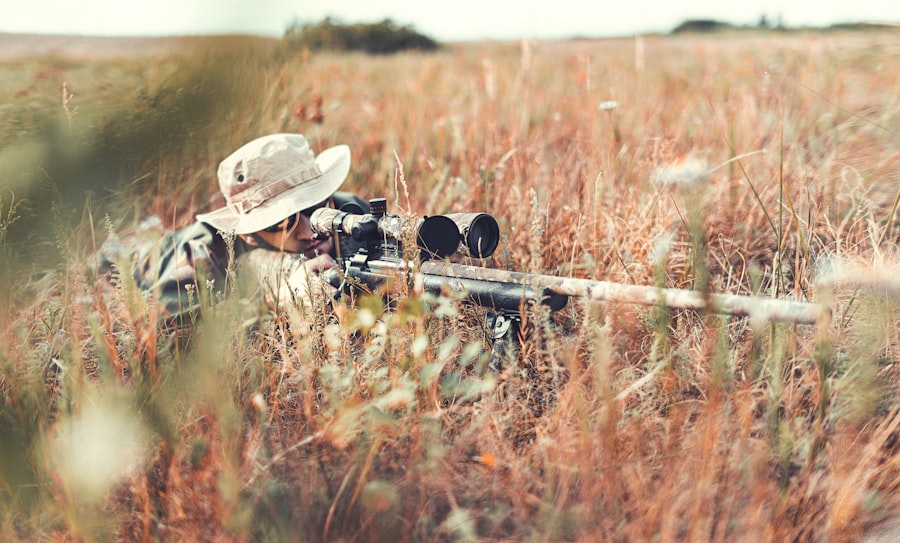
Stalking and ambushing are two common strategies used in muzzleloader elk hunting. Stalking involves quietly moving towards an elk or group of elk in order to get within shooting range. This requires patience, stealth, and careful observation of the animal’s behavior. Move slowly and deliberately, taking advantage of cover such as trees, rocks, or vegetation.
Ambushing involves setting up in a strategic location and waiting for elk to come within range. This can be done near water sources, feeding areas, or along known travel routes. Choose a spot with good visibility and cover, and remain still and quiet until an opportunity presents itself. Patience is key when using this strategy, as it may take time for elk to appear.
Staying hidden and quiet while hunting is crucial for both stalking and ambushing. Wear camouflage clothing that matches the surrounding environment, and use scent-blocking products to minimize your odor. Avoid sudden movements and keep noise to a minimum. Take advantage of natural cover such as trees or rocks to break up your silhouette and blend in with your surroundings.
The Importance of Stealth: How to Approach Elk Without Being Detected
Being stealthy is essential when approaching elk, as they have excellent hearing and can detect even the slightest noise. Move slowly and deliberately, taking care to avoid stepping on twigs or rustling leaves. Walk heel-to-toe to minimize noise, and use hand signals or whispers when communicating with hunting partners.
Avoiding detection by scent is also crucial when hunting elk. Elk have a keen sense of smell and can detect human odor from a distance. Use scent-blocking clothing and sprays to minimize your scent, and consider using cover scents such as pine or earth to mask your presence. Approach elk from downwind whenever possible to avoid being detected.
Mastering the Shot: Tips for Accurate Muzzleloader Shooting in the Field
Accuracy is paramount when hunting with a muzzleloader, as the slower rate of fire means you may only get one shot at an elk. Practice regularly at the range to improve your shooting skills and become familiar with your muzzleloader’s capabilities. Use a shooting stick or bipod for stability, especially when shooting from a standing position.
When taking a shot, it is important to adjust for distance and wind. Use a range finder to determine the distance to your target, and adjust your aim accordingly. Consider using a ballistic chart or app to help calculate the necessary adjustments for bullet drop at different distances. Take wind direction into account and aim slightly into the wind to compensate for drift.
Handling and Cleaning Your Muzzleloader: Maintaining Your Equipment for Optimal Performance
Proper maintenance is essential for keeping your muzzleloader in optimal condition. After each use, thoroughly clean the barrel and breech plug using a cleaning kit specifically designed for muzzleloaders. Remove any residue or fouling to prevent corrosion and ensure reliable performance.
Store your muzzleloader in a dry place to prevent moisture damage. Consider using a gun safe or airtight container to protect it from dust, humidity, and pests. Regularly inspect your muzzleloader for wear and tear, paying close attention to the barrel, breech plug, and firing mechanism. Replace any worn or damaged parts as needed.
The Thrill of the Hunt: Capturing the Magic of Elk Hunting with a Muzzleloader
Hunting elk with a muzzleloader is an exhilarating experience that allows you to connect with nature on a deeper level. The challenge of using a muzzleloader adds an extra element of excitement and satisfaction when you are able to successfully harvest an elk. Take the time to appreciate the beauty of the wilderness and the wildlife you encounter along the way.
To fully enjoy the experience, it is important to stay safe and ethical while hunting. Follow all safety guidelines and regulations, including wearing blaze orange to make yourself visible to other hunters. Use a safety harness when hunting from elevated positions such as tree stands. Practice ethical hunting by only taking shots that you are confident will result in a clean and humane kill.
Safety First: Essential Precautions and Guidelines for Muzzleloader Hunting in the Wild
Safety should always be the top priority when hunting with a muzzleloader. Treat every firearm as if it is loaded, even if you believe it is unloaded. Always point the muzzle in a safe direction and keep your finger off the trigger until you are ready to shoot. Be aware of your surroundings and never shoot at a target that you cannot positively identify.
Wearing blaze orange is crucial for visibility and safety, as it helps other hunters distinguish you from game animals. Additionally, using a safety harness when hunting from elevated positions such as tree stands can prevent falls and serious injuries. Always follow ethical guidelines for hunting, such as obtaining the necessary permits and licenses, respecting private property, and only taking shots that you are confident will result in a clean and humane kill.
Muzzleloader hunting for elk is an exciting and challenging pursuit that requires skill, patience, and preparation. Understanding the equipment and techniques involved, as well as taking the necessary precautions for safety and ethical hunting, will greatly enhance your chances of success. Embrace the thrill of the hunt, appreciate the beauty of the wilderness, and enjoy the experience of muzzleloader hunting for elk.
If you’re interested in muzzleloader elk hunting, you might also enjoy reading our article on “How to Hunt Jackrabbits.” Jackrabbit hunting can be an exciting and challenging pursuit, and this article provides valuable tips and techniques for a successful hunt. Whether you’re a seasoned hunter or just starting out, this article will help you improve your skills and increase your chances of bagging a jackrabbit. Check it out here!
FAQs
What is muzzleloader elk hunting?
Muzzleloader elk hunting is a type of hunting where hunters use a muzzleloading firearm to hunt elk. This type of hunting is popular among hunters who prefer a more traditional and challenging hunting experience.
What is a muzzleloader firearm?
A muzzleloader firearm is a type of gun that is loaded through the muzzle or the open end of the gun’s barrel. Muzzleloaders are typically single-shot firearms that require the shooter to manually load the gunpowder, bullet, and primer.
What are the advantages of using a muzzleloader for elk hunting?
Using a muzzleloader for elk hunting can provide a more challenging and rewarding hunting experience. Muzzleloaders are also quieter than modern firearms, which can make them a good choice for hunters who want to avoid spooking the elk.
What are the regulations for muzzleloader elk hunting?
Regulations for muzzleloader elk hunting vary by state and can include restrictions on the type of muzzleloader firearm that can be used, the caliber of the firearm, and the type of ammunition that can be used. Hunters should check with their state’s wildlife agency for specific regulations.
What is the best time of year for muzzleloader elk hunting?
The best time of year for muzzleloader elk hunting can vary depending on the location and climate. Generally, the fall season is the most popular time for elk hunting, as this is when the elk are in their mating season and are more active. Hunters should also consider the weather conditions and the availability of hunting permits when planning their hunt.
What are some tips for muzzleloader elk hunting?
Some tips for muzzleloader elk hunting include scouting the area before the hunt, using scent control to avoid spooking the elk, and practicing shooting with the muzzleloader firearm to ensure accuracy. Hunters should also be prepared for the physical demands of the hunt, as elk hunting can require hiking and carrying heavy equipment.

Herb has been a longtime lover of the outdoors. Whether it be hunting, camping, fishing or just getting outside to reset. Proud father and animal lover. Bourbon anyone?

by
Tags:

Categories
- Big Game Hunting (301)
- Deer (202)
- Reviews (3)
- Shooting (16)
- Slingshot (1)
- Small Game Hunting (42)
- Upland Hunting (126)
- Waterfowl Hunting (3)


